Facts are powerful and stubborn things. Unfortunately, some on the Left have tried to advance their arguments by using facts about state murder rates that, while technically true, are at best meaningless when taken out of context and at worst misleading and downright dangerous when used as the basis for public policy decisions.
Enter the “Red State Murder Problem.” It sounds ominous, but it’s not. It is also highly misleading.
Those on the Left know that their soft-on-crime policies have wreaked havoc in the cities where they have implemented those policies. It is not hard to understand why “reforms” such as ending cash bail, defunding the police, refusing to prosecute entire categories of crimes, letting thousands of convicted felons out of prison early, significantly cutting the prison population, and other “progressive” ideas have led to massive spikes in crime—particularly violent crime, including murder—in the communities where those on the Left have implemented them.
Left-wing politicians and their backers recognize that rising crime rates and the lack of a general sense of safety that follows are a problem for them and their chances for reelection. In fact, recent polls show that voters care a lot about rising crime—an issue that is second only to rising, rampant inflation and the lackluster economy. So the Left is engaging in political traditions as old as time: obfuscation, finger pointing, and blame shifting.
One liberal organization—The Third Way—even went so far as to publish a “study” arguing that Republicans are actually to blame for the spike in murders across the country. The not-so-subtle suggestion the study pushes is that those on the Left are not responsible for rising crime rates because crime is rising everywhere—especially in Republican-led states. Fighting for their political survival, Left-wing politicians such as Gavin Newsom and Larry Krasner have recently started to parrot the “results” of this study.REF
But crime tends to be a hyper-localized phenomenon. State-level data are generally meaningless—except as a tool with which to score political points. More to the point, when the crime statistics from the deep-blue big cities within these otherwise deep-red states are removed, what happens? The state-level crime rates fall—in some cases, dramatically.
Crime Trends
Until recently, crime, including violent crime, has been declining across the United States since the peak of the last crime wave in 1992.REF Not surprisingly, since incarceration trails crime waves, incarceration rates have also been falling dramatically since they last peaked in 2008.REF
Unfortunately, however, the 25-plus year drop in crime since 1992 has ended for many cities across the United States. The rise in crime, especially violent crime, started taking place around 2015 after the confluence of a series of events that took place over the course of a few years.
Those events include police-involved shootings of black community members,REF the defund the police movement,REF the election of rogue prosecutors funded or inspired by George Soros and other elitist billionaires,REF and the “Ferguson/Minneapolis Effect”REF by which unwarranted public scrutiny of police resulted in police drastically reducing proactive policing. Crime was rising in select cities across the country before the global COVID-19 pandemic struck in March 2020, but it rose even more significantly after the death of George Floyd on May 25, 2020.
The cumulative effect of these events contributed to and in large part set the conditions for increased crime across much of the country, especially in cities where the toxic trio of rogue prosecutors, defund the police zealotry, and demonization/demoralization of the police existed. In those cities and others with some mixture of this toxic trio crime has exploded across most categories, including but not limited to murder.
As the old saying goes, the best defense is a good offense. So instead of defending their calls to defund the police, the elections of pro-criminal rogue prosecutors, or their pattern and practice of demonizing police, some on the Left have decided to flip the narrative and argue that it is the Republican states that have the real crime rate problem, especially when it comes to murder.
The Red State Murder Herring
On March 15, 2022, a left-wing advocacy organization called The Third Way published a 15-page study with the provocative title “The Red State Murder Problem.”REF Written by Jim Kessler, a long-time Democratic policy director to Representative/Senator Charles “Chuck” Schumer, and Kylie Murdock, a former intern for Congresswoman Barbara Lee and volunteer for Elizabeth Warren for President, the study states that “murder rates are far higher in Trump-voting red states than Biden-voting blue states.”REF So that the reader won’t miss the political drift, the authors add, “And sometimes, murder rates are highest in cities with Republican mayors.”REF
The “crime rate” is the number of crimes reported to law enforcement agencies for every 100,000 persons within a given population. It is calculated by dividing the number of reported crimes by the total population. The result is then multiplied by 100,000.
Not surprisingly, dozens of media outlets, including The Washington Post,REF The Hill,REF Inside Edition,REF Politifact,REF The Daily Beast,REF Los Angeles Magazine,REF the San Francisco Examiner,REF NBC NewsREF and others, picked up the “study” and breathlessly reported on its “findings.”REF Even Paul Krugman, New York Times opinion columnist and economist, has joined the echo chamber, albeit with an unconvincing and divorced-from-reality opinion piece wherein he opines that “nobody knows for sure what caused the surge.”REF
We have a pretty good idea, and many voters apparently are starting to figure it out as well.
The study’s authors and those reporting its results took advantage of the fact that the average reader does not know much about crime trends, how crime rates are calculated, and at what level (city/county/state, etc.) these statistics should be reviewed. Because of that, The Third Way’s study sounds important and shocking to most readers who visit these “news” websites.
As noted earlier, however, most crime is hyperlocalized, so the fundamental flaw with the study and the reason it does not deserve any serious consideration is that the “murder rate” in each state is largely a function of the large number of murders in a state’s biggest city or cities.REF A super majority of those cities, even in otherwise red states, are deep blue and run by left-wing ideologues.
When you remove the crime-infested, homicide-riddled cities from the state murder rate featured in the Third Way study, you dramatically lower the murder rate for that state, upending their conclusions and exposing the piece for what it really is: a straightforward attempt at political projection dressed up as a “study.”
Said another way, Kessler and Murdock did their level best as political operatives to blame their political opponents for the very thing—rising crime—that leftist policies at the city and county levels have caused.
While a state’s murder rate is perhaps politically interesting, a more accurate reflection of what is actually happening on the ground is gained by reviewing localized murder rates, such as murder rates in a city or county. What does this review show?
Table 1 lists the 30 cities with the highest murder rates in the United States as of June 30, 2022.
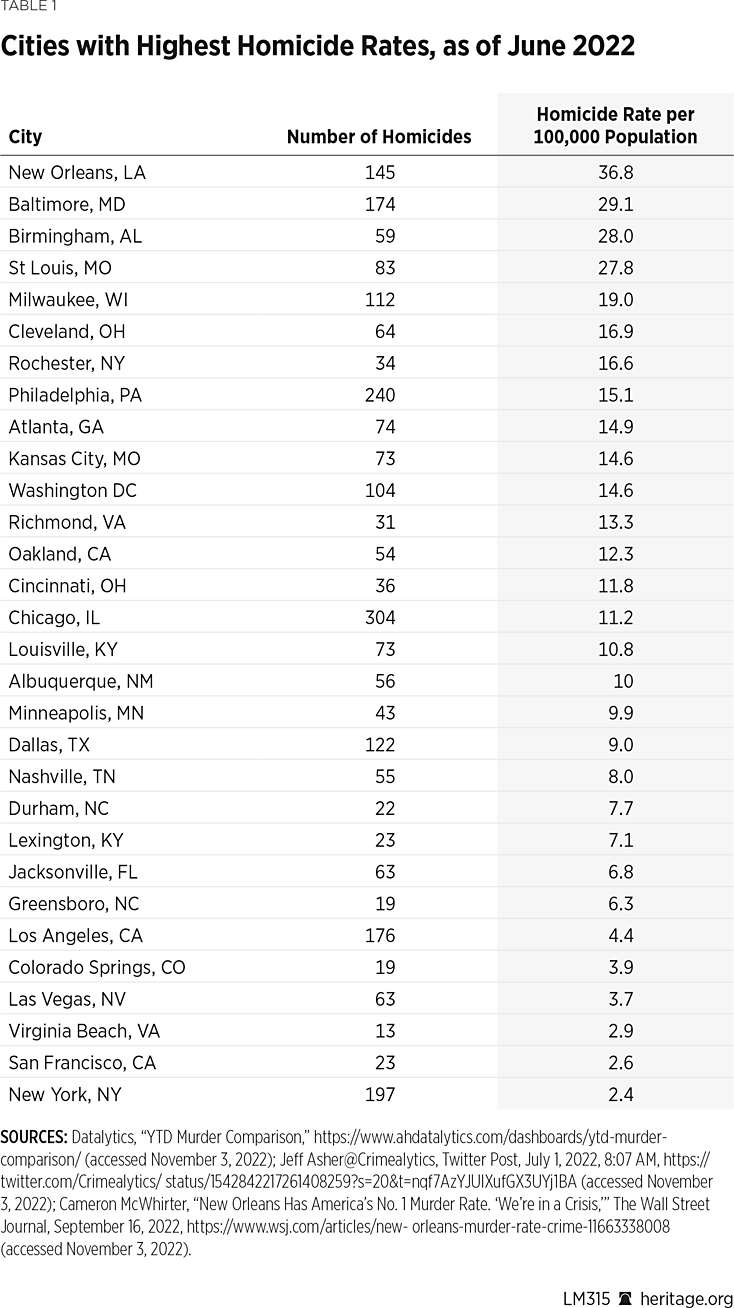
Not surprisingly, of those 30 cities, 27 have Democratic mayors, the exceptions being Lexington and Jacksonville, which have Republican mayors, and Las Vegas, whose mayor is an Independent. And within those 30 cities there are at least 14 Soros-backed or Soros-inspired rogue prosecutors. Those Soros bought-and-paid-for or inspired rogue prosecutors include:
- Jason Williams, New Orleans Parish District Attorney;
- Marilyn Mosby, Baltimore City State’s Attorney;REF
- Kim Gardner, St. Louis Circuit Attorney;
- John T. Chisholm, Milwaukee County District Attorney;
- Larry Krasner, Philadelphia District Attorney;
- Kim Foxx, Cook County (Chicago) State’s Attorney;
- Raul Torrez, Bernalillo County (Albuquerque) District Attorney;
- Mike Freeman, Hennepin County (Minneapolis) Attorney;
- John Creuzot, Dallas County District Attorney;
- Glenn R. Funk, Nashville District Attorney General;
- Santana Deberry, Durham District Attorney;
- George Gascon, Los Angeles County District Attorney;
- Chesa Boudin, San Francisco District Attorney;REF and
- Alvin Bragg, Manhattan District Attorney.
There were 2,554 homicides in those 30 cities through June 2022. In the 14 cities with Soros-backed rogue prosecutors, there were 1,752 homicides, representing 68 percent of homicides in the 30 top homicide cities in the United States.
Every Soros rogue prosecutor listed above is a Democrat.
A More Detailed Analysis
For a deeper dive into the numbers, we performed a more detailed analysis by examining how states’ homicide rates are influenced by particular high-crime counties. Although the authors of the “The Red State Murder Problem” provide the state-by-state data used in their study, they do not directly provide the county-level data necessary to answer this question.REF County Health Rankings & Roadmaps (CHR&R), a program of the University of Wisconsin Population Health Institute, however, does provide these comprehensive data.REF Specifically, CHR&R provides detailed data on health care, education, economic, and demographic variables, including homicide rates and overall state populations on a county-by-county basis all across the country.
Table 2 provides homicide rate rankings across all 50 states based on homicide data from 2014–2020.REF
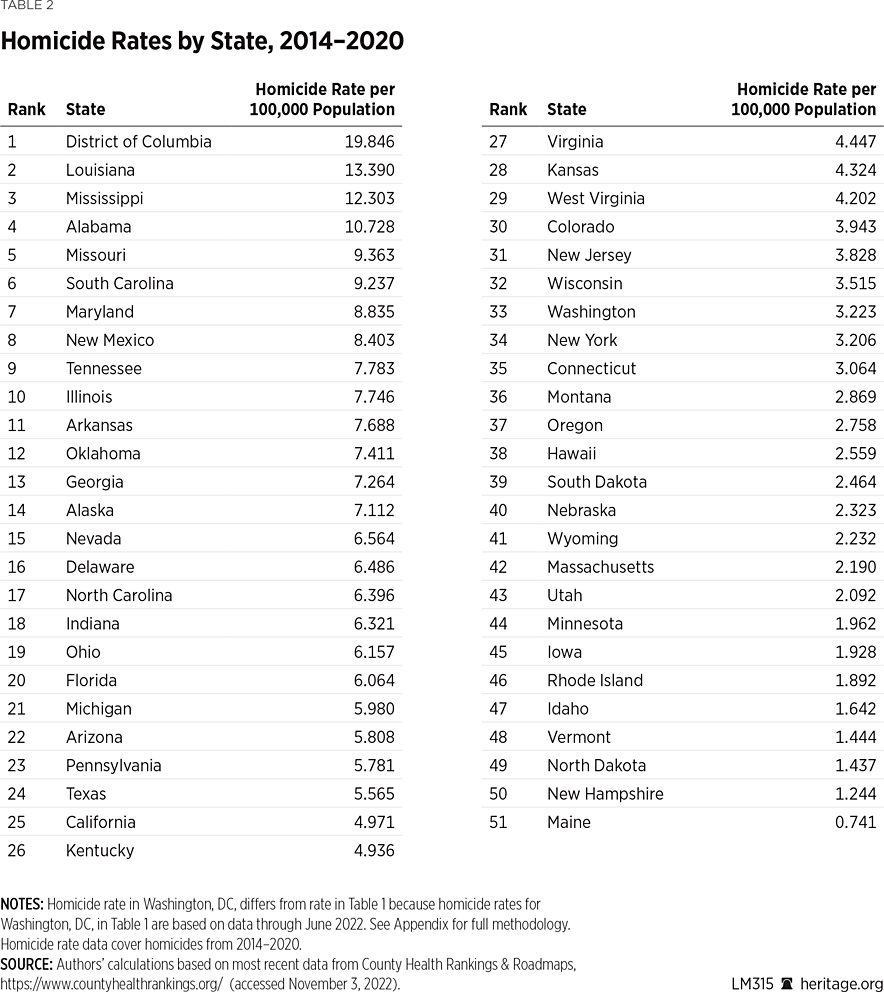
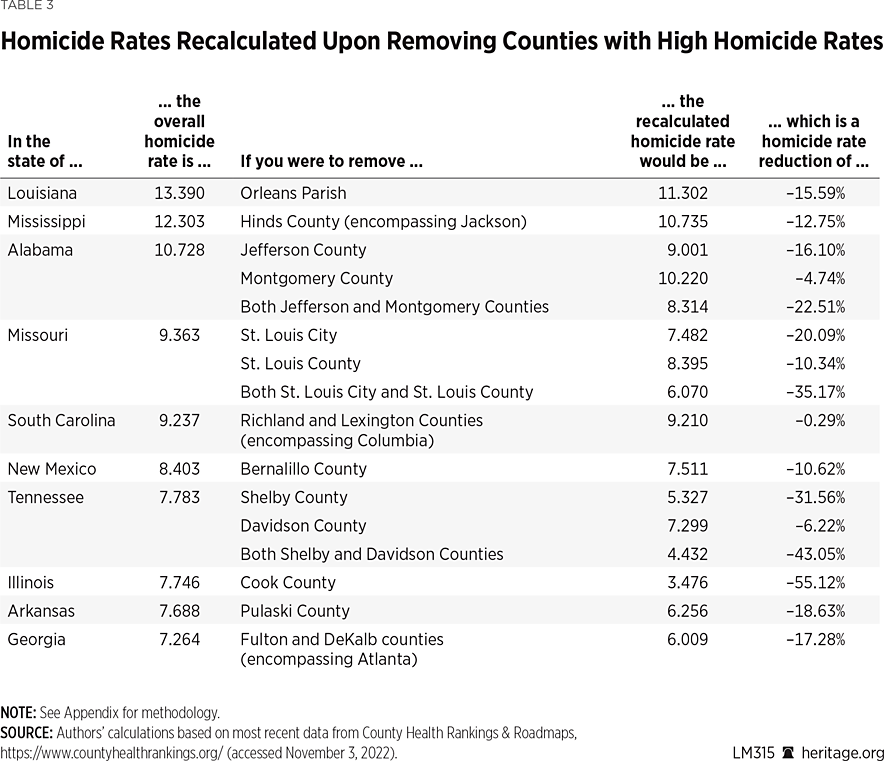
A closer examination of the local officials in the counties and cities listed above reveals that the vast majority of them are Democrats.
- In Orleans Parish, Louisiana (which encompasses New Orleans), District Attorney Jason Williams, Mayor LaToya Cantrell, and all seven members of the City Council are Democrats.REF
- In Hinds County, Mississippi, District Attorney Jody E. Owens and all five members of the Board of Supervisors are Democrats.REF In Jackson County, Mississippi, District Attorney Angel Myers McIlrath is a Republican, as are four of the five members of the Board of Supervisors,REF but the City of Jackson Mayor Chokwe Antar Lumumba is a Democrat.
- In Jefferson County, Alabama, the Board of Commissions consists of three Republicans and two Democrats.REF District Attorney Danny Carr is a Democrat, as is Birmingham Mayor Randall Woodfin.
- The Montgomery County, Alabama, Board of Commissions consists of three Republicans and two Democrats.REF District Attorney Daryl Bailey is a Democrat, as is Montgomery Mayor Steven Reed.
- The elected officials in the City of Saint Louis, Missouri, are all Democrats. The 28 members of the Board of Alderman are all Democrats, as are Circuit Attorney (the equivalent of a local district attorney) Kim Gardner and Mayor Tishaura Jones.
- Saint Louis County is equally lopsided with elected Democrats, including five of the seven members of the County Council and District Attorney Wesley Bell.REF
- The City of Columbia, South Carolina, is unique in that it straddles two counties, Richland and Lexington. Richland County Solicitor (the equivalent of the local district attorney) Byron E. Gipson is a Democrat, as are nine of the 11 members of the Richland County Council.REF Lexington County Solicitor Rick Hubbard is a Republican, as are all nine members of the Lexington County Council.REF
- In Bernalillo County, New Mexico (which includes Albuquerque), four of the five members of the Board of Commissioners are Democrats, as are Mayor Tim Keller and District Attorney Raul Torrez.REF
- In Shelby County, Tennessee, nine of the 13 members of the Board of Commissioners are Democrats, as are Memphis Mayor Jim Strickland and Shelby County District Attorney Steve Mulroy.REF
- In Davidson County, Tennessee, members of the Metropolitan Nashville Council are all listed as nonpartisan. However, both District Attorney Glenn Funk and Mayor John Cooper are Democrats.
- Fifteen of the 17 members of the Cook County, Illinois (which encompasses Chicago) Board of Commissioners are Democrats,REF as are Cook County State’s Attorney Kim Foxx, the first Soros rogue prosecutor, and Chicago Mayor Lori Lightfoot.
- Nine of the 14 members of the Pulaski County, Arkansas, Quorum Court (the county government’s legislative body) are Democrats,REF as are Mayor Frank Scott Jr. and Prosecuting Attorney Larry Jegley of Pulaski County, which encompasses Little Rock.
- In Georgia, all seven members of the Dekalb County Board of Commissioners are Democrats, as are District Attorney Sherry Boston and Atlanta Mayor Andre Dickens.REF DeKalb County encompasses the eastern section of the City of Atlanta.
- Four of the seven members of the Board of Commissioners of Fulton County, Georgia, which encompasses the rest of Atlanta, are Democrats,REF as is District Attorney Fani Willis.
The authors of the Third Way “study” either intentionally neglected or simply don’t understand that the “criminal justice system” within the 50 states is not a homogeneous nationwide system, but rather an amalgamation of thousands of microcosms consisting of federal, state, county, and local law enforcement agencies and prosecutors and unique approaches to the enforcement of state law. There are, for example, 3,143 counties in this country. Violations of state law are prosecuted largely at the county or city level.
Your public safety as a resident is dramatically impacted by your district attorney and whether he or she is a Soros rogue prosecutor or a law-and-order prosecutor, by your police department, and by whether the local politicians support and adequately fund the police and prosecutor’s offices.
This is why the Soros rogue prosecutor movement has concentrated its fire at identifying, recruiting, and funding candidates for local district attorney races. By elevating pro-criminal, anti-victim zealots into office, the rogue prosecutor movement destabilizes the safety of the community, treats criminals as victims and the police as the criminals, and ignores real victims.
Whether a state as a whole voted for Donald Trump or Joe Biden has nothing whatever to do with the homicide rates within its constituent parts. The authors of the Third Way “study” are either oblivious to this fact or, as we suspect, aware of this but nonetheless determined to flip the political narrative. As we demonstrate, however, the high murder rate is almost exclusively cabined in cities run by Democrats and with Democrat district attorneys, many of whom are Soros bought-and-paid-for rogue prosecutors or inspired by Soros, groups like the egregiously misnamed Fair and Just Prosecution, and other battering rams of the movement.
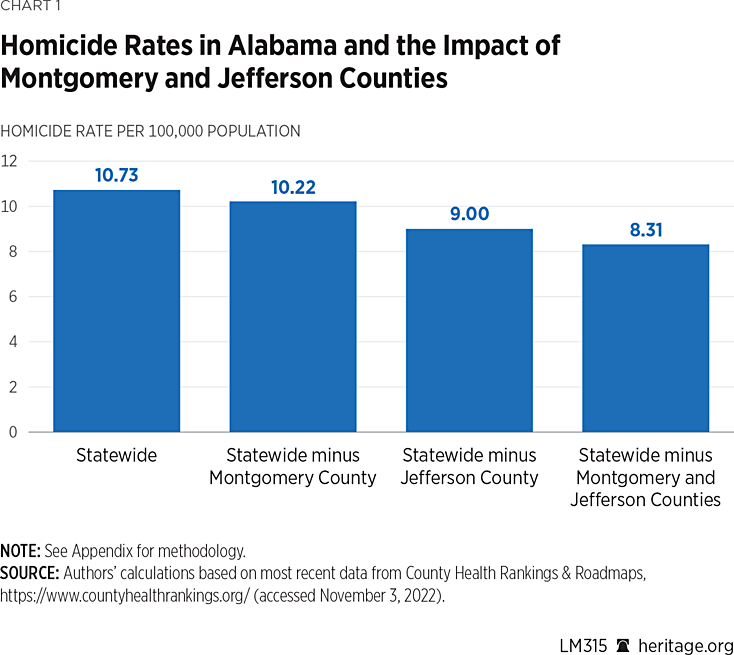
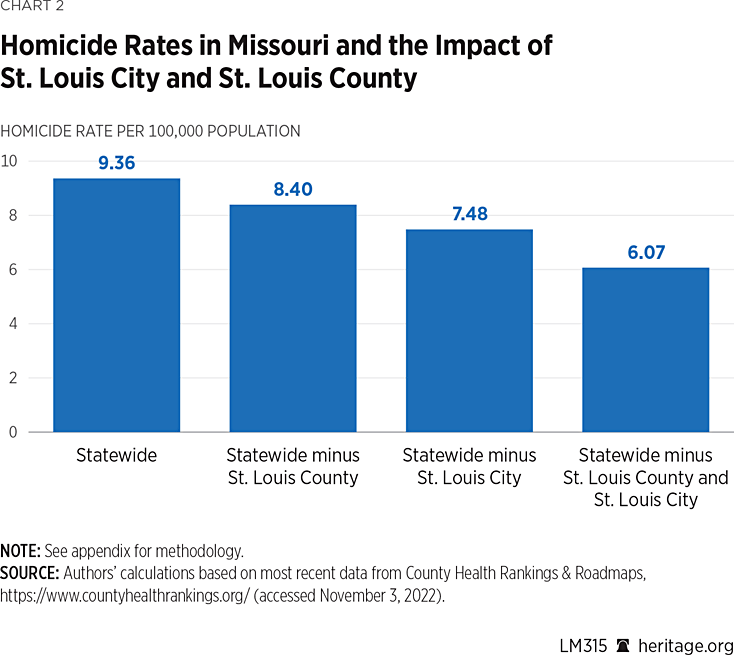
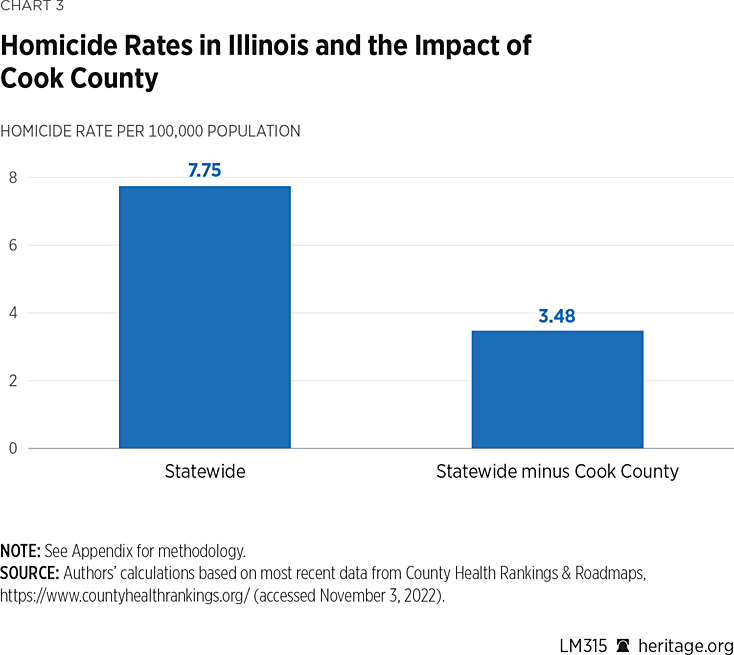
As Table 2 illustrates, Washington, DC, has the nation’s highest homicide rate at 19.846 homicides per 100,000 residents yet is completely neglected in “The Red State Murder Problem.” Louisiana, Alabama, and Mississippi are also highly ranked with homicide rates ranging from 13.390 to 10.728 per 100,000 residents).REF
Louisiana’s homicide rate is heavily dependent on Orleans Parish, which has a homicide rate of 36.126 homicides per 100,000 residents. Removing this locality drops the state’s homicide rate from 13.390 to 11.302, a 15.59 percent reduction.
Alabama’s overall homicide rate is also heavily influenced by a few localities. For example, removing Jefferson County drops the state’s homicide rate from 10.728 to 9.001, a 16.10 percent reduction, and removing Montgomery County drops the homicide rate to 10.220, a 4.74 percent reduction. Dropping both lowers the homicide rate to 8.314, a 22.51 percent reduction, and would lower the state’s ranking in Table 2 from fourth to eighth in the nation. These dramatic drops are illustrated in Chart 1.
Missouri’s overall homicide rate is marked by similar behavior. St. Louis City and St. Louis County heavily influence the state’s homicide rate, having 46.235 and 14.387 homicides per 100,000 residents, respectively. Removing St. Louis City lowers the state’s homicide rate from 9.363 to 7.482 per 100,000 residents, a 20.09 percent reduction. Removing St. Louis County lowers the homicide rate to 8.395 per 100,000 residents,) a 10.34 percent reduction, while dropping both counties reduces the state’s homicide rate by 35.17 percent to 6.070 homicides per 100,000 residents. These reductions are apparent in Chart 2. Looking at Table 2, removing both counties drops Missouri’s homicide ranking from fifth to 20th in the nation.
New Mexico’s homicide rate is heavily dependent on Bernalillo County, encompassing the City of Albuquerque. Bernalillo County is the state’s most populous county and has a homicide rate of 10.241 homicides per 100,000 residents. Removing this county lowers the state’s homicide rate from 8.403 to 7.511 per 100,000 residents, a 10.62 percent reduction, and lowers the county’s homicide rate from eighth to 11th in the nation.
Georgia’s homicide rate is heavily influenced by crime in Atlanta, encompassing Fulton and DeKalb Counties. Dropping these two counties (which have homicide rates of 13.407 and 13.272 per 100,000 residents, respectively) causes the state’s homicide rate to fall from 7.264 to 5.999, a 17.3 percent reduction, and the state’s ranking in Table 2 to fall from 13th to 21st in the nation.
Arkansas’ homicide rate is impacted by Pulaski County, which has 17.199 homicides per 100,000 residents. Removing this county drops the state’s overall homicide rate from 7.688 to 6.256, a 18.63 percent reduction.
Tennessee is heavily influenced by crime in Memphis and Nashville. Removing Shelby County (with a homicide rate of 23.424 per 100,000 residents) surrounding Memphis results in a reduction from 7.783 to 5.327 (per 100,000 residents), a 31.56 percent change. Dropping Davidson County (with a homicide rate of 12.074 per 100,000) surrounding Nashville results in a reduction from 7.783 to 7.299 (per 100,000 residents), a 6.22 percent change. Dropping both counties brings down the state’s homicide rate to 4.432 per 100,000 residents, a 43.05 percent reduction, and lowers the state’s national ranking in Table 2 from ninth to 27th.
Finally, Cook County, Illinois, is another highly influential county. Home to Chicago, Cook County boasts a homicide rate of 13.99 homicides per 100,000 residents, and dropping it from the state’s overall homicide rate calculation lowers the state’s rate from 7.746 to 3.476, a 55.1 percent reduction. (See Chart 3.) This reduction causes the state’s ranking in Table 1 to plummet from 10th to 32nd in the nation.
It is apparent that some states’ homicide rates are determined heavily by crime in certain counties. It is thus naïve and nonsensical to make partisan claims about states’ overall crime rates while completely neglecting how various localities contribute to these rates.
Policies, Not COVID
One of the Left’s talking points is that the COVID-19 caused or at least contributed to the general rise in crime and that the rise in crime started during the pandemic. There are no reputable studies that prove that crime increased as a direct result of COVID lockdowns—which makes sense. Many people across the country were locked down, including in the inner cities where most crime takes place. What the data do show is that crime, including violent crime, was rising in cities with the toxic trio prior toREF the onset of the pandemic and that the death of George Floyd, which happened in May 2020, led to a rise in murders and auto theft in key cities.REF
But numbers themselves do not begin to tell the whole story of why crime rates in these homicide hellholes have risen. Starting in 2016, with the election of the first Soros rogue prosecutor, Kim Foxx, in Chicago, cities with rogue prosecutors have imposed policies that all—each and every one of them—inure to the benefit of criminals, as we have detailed in our scholarship for the past two years.
Those policies include but are not limited to:
- Refusing to prosecute entire categories of misdemeanor crimes, including theft, drug possession, shoplifting, receiving stolen property, breaking and entering, destruction of property, disturbing the peace, disorderly conduct, resisting arrest, and more.
- Forbidding prosecutors from including sentencing enhancements or allegations of prior convictions or special circumstances for egregious crimes or actions.
- Forbidding prosecutors from seeking the death penalty in any case.
- Forbidding prosecutors from seeking life without parole sentences for any crime.
- Refusing to prosecute violent teenagers in adult court for such crimes as murder, child abuse, and rape.
- Requiring prosecutors to ask for the release of duly convicted violent felons, whose appeals have been denied, after these felons have served as least 15 years of a longer sentence.
- Prohibiting or limiting prosecutors from asking for bail to ensure the presence of the defendant at the next court hearing and/or taking into consideration the defendant’s prior criminal record.
Conclusion
The foregoing policies—and dozens of other pro-criminal, anti-victim policies—have contributed to the lawlessness across blue cities and the steep rise in crime rates. To suggest now that Republican elected officials who have followed different policies have contributed to crime increases is at best laughable.
Charles D. Stimson is Deputy Director of the Edwin Meese III Center for Legal and Judicial Studies and Senior Advisor to the President at The Heritage Foundation. He also is a Senior Fellow and Manager of the National Security Law Program in the Meese Center. Zack Smith is a Legal Fellow and Manager of the Supreme Court and Appellate Advocacy Program in the Meese Center. Kevin D. Dayaratna, PhD, is Chief Statistician, Data Scientist, and Senior Research Fellow in the Center for Data Analysis at The Heritage Foundation.
Appendix
We utilized 2021 homicide data from County Health Rankings & Roadmaps (CHR&R), a program of the University of Wisconsin Population Health Institute. CHR&R provides point and interval estimates for county-level and state-level homicide rates from 2014–2020 and population estimates from 2020.
We took point estimates of these rates and county-level population statistics to compute the raw number of homicides in each county. These estimates were rounded to the nearest integer to avoid fractional homicides and subsequently summed to generate an overall pooled estimate of the state’s raw number of homicides from 2014—2020, which were then divided by the state’s population to determine an overall state-level homicide rate.
These state-level homicide rates differ slightly from the overall state homicide rates reported in CHR&R, likely because the authors of the dataset used a population figure that is different from what is available in the dataset. Nevertheless, the alternative state rankings presented in Table 1 do not differ appreciably from these rankings using the dataset’s original homicide rates. Furthermore, these alternative rankings are necessary for an understanding of particular counties’ impact on overall state-level homicide rates as examined in this report.





